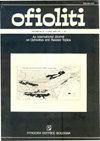39 Ma U-Pb zircon age for the Shaki-Rash gabbro in the Bulfat igneous complex, Kurdistan region, Iraqi Zagros Suture zone: rifting of an Intra-Neotethys Cenozoic arc
IF 1.3
4区 地球科学
Q2 GEOLOGY
引用次数: 6
Abstract
The suprasubduction Bulfat Igneous Complex in NE Iraq is one of the discontinuous Neotethys oceanic lithosphere fragments preserved in the Zagros region. Reported here are new geochronological, petrological and geochemical data from this assemblage. At the study locality, Eocene arc-related magmatic rocks are intruded by extensive dykes of Shaki-Rash gabbro. The key reason to focus on these rocks is the remarkable lack of hydrothermal alteration, including preservation of very fresh olivine. Besides olivine the gabbros contain plagioclase and clinopyroxene, with lesser orthopyroxene, biotite, brown hornblende and alkali feldspar. From mineral chemistry, the crystallization conditions of the olivine gabbros are ~ 950-1050°C and ~ 5-3 Kbar. Shaki-Rash gabbro shows alkaline affinity. SHRIMP U-Pb dating of magmatic zircon from the gabbro yielded a mean 206Pb/238U age of 39.0±0.5 Ma (Eocene). Most of the Shaki-Rash gabbro samples have Ti/V of 100 to 50 and fall in the back-arc basin (BAB) and alkaline fields, while on a Nb/Yb-Th/Yb diagram, most samples fall within the MORB-OIB array and plot in proximity to E-MORB. Primitive-mantle-normalized trace-element patterns show enrichment in the large ion lithophile elements without depletion of the high-field-strength elements. These geochemical signatures and their field setting advocate for the formation of these dikes in an extensional tectonic environment, such as an intra-arc rift.伊拉克扎格罗斯缝合带库尔德斯坦地区Bulfat火成岩杂岩Shaki-Rash辉长岩39 Ma U-Pb锆石年龄:内新特提斯新生代弧的裂陷作用
伊拉克东北部的超俯冲Bulfat火成岩杂岩是扎格罗斯地区保存的不连续的新特提斯洋岩石圈碎片之一。本文报道了来自该组合的新的地质年代、岩石学和地球化学数据。在研究地点,始新世弧相关的岩浆岩被Shaki Rash辉长岩的大量岩脉侵入。关注这些岩石的关键原因是明显缺乏热液蚀变,包括保存了非常新鲜的橄榄石。辉长岩除橄榄石外,还含有斜长石和单斜辉石,以及少量斜方辉石、黑云母、棕色角闪石和碱性长石。从矿物化学角度来看,橄榄石辉长岩的结晶条件为~950-1050°C和~5-3Kbar。Shaki Rash辉长岩显示出碱性亲和力。辉长岩岩浆锆石的SHRIMP U-Pb定年得出的206Pb/238U平均年龄为39.0±0.5 Ma(始新世)。大多数Shaki Rash辉长岩样品的Ti/V为100至50,落在弧后盆地(BAB)和碱性区,而在Nb/Yb-Th/Yb图上,大多数样品落在MORB-OIB阵列内,并在E-MORB附近绘图。原始地幔归一化微量元素模式显示大离子亲石元素富集,而高场强元素不贫化。这些地球化学特征及其野外环境主张在伸展构造环境中形成这些岩墙,如弧内裂谷。
本文章由计算机程序翻译,如有差异,请以英文原文为准。
求助全文
约1分钟内获得全文
求助全文
来源期刊

Ofioliti
地学-地质学
CiteScore
2.40
自引率
7.70%
发文量
1
期刊介绍:
Since 1976, Ofioliti provides an international forum for original contributions and reviews in the field of the geodynamics, petrology, geochemistry, biostratigraphy, stratigraphy, tectonics and paleogeography applied to ophiolitic terrains and modern oceanic lithosphere, including their sedimentary cover. Studies of topics such as geodynamics of the mantle, the evolution of orogens including ophiolites and paleoceanography are also welcome
 求助内容:
求助内容: 应助结果提醒方式:
应助结果提醒方式:


